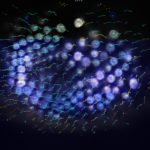Link to Pubmed [PMID] – 19756723
Link to DOI – 10.1007/s00424-009-0711-x
Pflugers Arch 2009 Nov; 459(1): 115-30
We assessed the involvement of harmonin-b, a submembranous protein containing PDZ domains, in the mechanoelectrical transduction machinery of inner ear hair cells. Harmonin-b is located in the region of the upper insertion point of the tip link that joins adjacent stereocilia from different rows and that is believed to gate transducer channel(s) located in the region of the tip link’s lower insertion point. In Ush1c (dfcr-2J/dfcr-2J) mutant mice defective for harmonin-b, step deflections of the hair bundle evoked transduction currents with altered speed and extent of adaptation. In utricular hair cells, hair bundle morphology and maximal transduction currents were similar to those observed in wild-type mice, but adaptation was faster and more complete. Cochlear outer hair cells displayed reduced maximal transduction currents, which may be the consequence of moderate structural anomalies of their hair bundles. Their adaptation was slower and displayed a variable extent. The latter was positively correlated with the magnitude of the maximal transduction current, but the cells that showed the largest currents could be either hyperadaptive or hypoadaptive. To interpret our observations, we used a theoretical description of mechanoelectrical transduction based on the gating spring theory and a motor model of adaptation. Simulations could account for the characteristics of transduction currents in wild-type and mutant hair cells, both vestibular and cochlear. They led us to conclude that harmonin-b operates as an intracellular link that limits adaptation and engages adaptation motors, a dual role consistent with the scaffolding property of the protein and its binding to both actin filaments and the tip link component cadherin-23.



